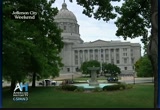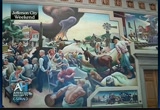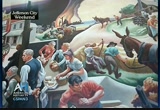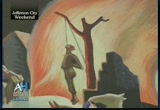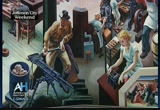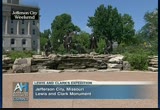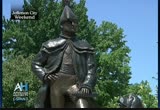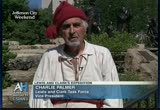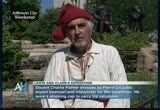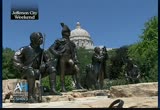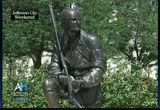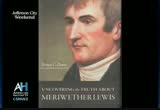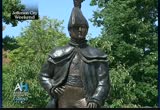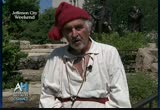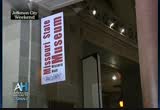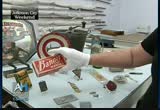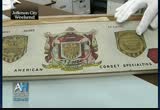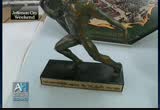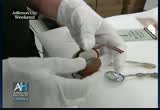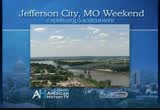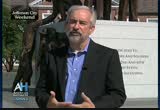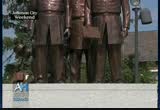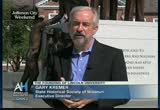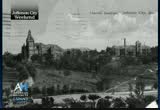tv [untitled] July 8, 2012 5:30pm-6:00pm EDT
5:32 pm
5:33 pm
depicts that period of time there's a child on here showing its rear end. worst yet, the mother's changing a dirty diaper, something they really didn't care for to see and couldn't believe he put something on the wall like that. he had to verify everything on the wall to be historically correct, and he did. when he got to the child, he said none of us would be here if our parents didn't change our diapers, and still caused lots of problems. there's tom pentergast on the wall, the political mob boss of kansas city during his time frame. he eventually went to prison and died shortly after that, but a lot of things they couldn't believe he put on the wall, like jesse james, he's an outlaw, why would you put that on the wall? and there's great things on the
5:34 pm
wall too, so it's a progression of missouri from the very beginnings to the modern age, well, as modern as 1936 gets when he actually painted the painting. the nice thing about the capital is you have an appeasing roman construction design, it is one of the most beautiful capitols in the united states to physically look at. we have trees surrounding us, we're not sterile, not just a building out in the middle of nothing. we have grasses and trees, 17 acres to walk around in. inside we have one of the most beautiful rotunda areas with the mural done by frank brinegrin, welsh artist from england. never saw the capitol in person or stepped foot in the state of missouri, but they do, they really bring the capitol together through some of the missouri history he read about and using his own technique, more of a european technique.
quote
5:35 pm
we have 41 paintings that talk about the history and resources found in missouri. the benton mural, the third floor, the busts of people who are famous who live in missouri who have some sort of impact around the world. all weekend long, american history tv is featuring the history of jefferson city, missouri, located near the center of this state in a region known as mid-missouri. hosted by
5:36 pm
well, the thing that excited me about being here today is the fact that it's june the 4th and the lewis and clark core of discovery passed through here just beyond those trees that you see over there. on june the 4th in 1804. that's 208 years ago. they were on their way to the pacific ocean, and as i say, they passed here and continued on up the missouri river. they followed the river up to the eastern slope of the rocky mountains. it was pre-louisiana purchase. thomas jefferson had
5:37 pm
the extent of $2,500. lewis had been jefferson's secretary. jefferson had known him for years. they were relatively close neighbors in virginia, so he knew lewis, he knew his capabilities, and he knew he was the man who could pull this off getting to the pacific ocean. clark had been lewis' immediate superior when they were in the army together on the frontier in ohio and illinois. he and clark formed a great friendship in the service so when lewis knew that this was coming and he had been selected to lead it, he said there's only one fella that i want to go with me as a co-captain would be william clark. meriwether lewis was a smart guy. unfortunately, he was a shy man and he didn't interact well with
5:38 pm
people. he was an outdoorsman, he spent his early years on the frontier, which is western virginia, and he was looking for things that were unfamiliar to him. he was looking for the indians. he was looking for plants, animals, birds, fish, whatever, and he carried that over with him on to the expedition. on the other hand, clark was a people person. he related well to the men and they to him, so really between the two of them, they had the mental horses to keep this expedition under control and on the way. they knew what to expect for much of their trip. once they got as far as st. louis, once they got past st. louis and st. charles, things changed because there were no
5:42 pm
it's also a book recently written about three years ago, and tom danisi thinks that he had malaria. now, there's five types of malaria, which i never knew, but he was subject to two of them, one in the brain and one in his abdomen and he was in excruciating pain whenever they would kick up, particularly the ones in the abdomen, and he was using opium and alcohol to temper his feelings, and he was -- he had been called back to washington by thomas jefferson because he had not written the journals as he had promised to do, translating them into a written form and printing them, and he ended up on the path that runs between nachas
5:43 pm
and nashville, and that night he showed very peculiar symptoms and behavior. two shots were fired. they think he committed suicide. there's also another story that people tell, and with justification and with some support, that he was murdered. we don't know, but he died in 1810. on the nachas trace. clark, as i said, was ahead of the indian department. he was eventually appointed governor of missouri and he also worked with the indians there. they loved -- the indians loved him. they called him red hair, because he was really -- he was really their friend. he listened to them. he helped them all that he possibly could, and he never really campaigned for the office of governor again, although he ran, his name was entered.
5:44 pm
he did not win, and he returned again to his position as the head of the indian affairs, which he kept on until he died, and he's now buried in the bell fountain cemetery in st. louis and we were an integral part, the missouri river and the rest of the state of missouri, was an integral part of that expedition. the entire expedition was about 7,000 miles and it took them two and a half years to do it, unbelievable, what they went through, what you read about it, it's awesome. absolutely awesome. all weekend, american history tv is joining our mediacom cable partner in jefferson city, missouri, to showcase its rich history. to learn more about our local content vehicles and 2012 tour, visit cspan.org/localecontent. we now continue with jefferson
5:45 pm
city. this is american history tv on c-span3. we're at the riverside collections facility, which is part of the missouri state museum in jefferson city. this facility has support functions for the public face in the state capitol. the main purpose is to store the many artifacts we have from the collection. last year, 2011, we were lucky enough to get a very large donation of artifacts, approximately 5,000 pieces all related to the 1904 st. louis world's fair. the fair came here as part of a series of international expositions, some of the most famous worldwide was the crystal palace expedition in the 1850s, there was an expedition in paris which the eiffel tower came from, chicago got the columbian exposition fair, which missouri
5:46 pm
tried really hard to get. and part of that, though, because of their efforts to get the 1893 fair, they were up and running on their efforts to get the next fair, the u.s. congress had decided we need to have a fair to celebrate this important piece of our history, and st. louis was awarded the fair that the u.s. congress had decided would happen on the anniversary of the louisiana purchase. i want to tell you a little bit about the souvenir aspect of the fairs, and this happened at many of them. at st. louis, essentially anything they could think of to put the name st. louis world's fair or louisiana purchase exposition on, they did. we have hundreds of plates, a lot of them with buildings, some with other things. there's a lot of cut glass items. we have a number of things that
5:47 pm
won gold medals at the fair from matches to crayons, to dr. pepper, which won a medal at the fair, a gold medal, so we have a number of those industrial objects, including a corset that we have here that was done especially for the fair. you wouldn't think that was important, but it was awarded a prize at the st. louis fair. companies tended to use their awards as advertising after the fact, so on their boxes, they would say, gold medal, or in here, highest award st. louis 1904. they would have replicas of the medals so that people could know that this is a wonderful product because it won an award at a
5:48 pm
fair and during the late 19th, early 20th century, having that award was a key part of promoting items that they were selling. we have a couple things from the jefferson guard. it was, essentially, a police force that was done particularly for the state fair, for the st. louis world's fair. we have a badge there. we also have, and it was 1904, so they didn't just have weapons we would think of today, they did actually have swords, and we're lucky enough to have the scaborb, the belt, and the sword itself, which was numbered, there was a limited number that was created just for the jefferson guard to use only during the exposition. the men who formed part of the guard, a lot of them would have been retired military.
5:49 pm
some of them would have still been civil war veterans, veterans of the spanish-american war, so in some ways it was ceremonial, it was an honor for them, but they did actually have real work to do, because sometimes the fair was nice and sometimes it was a bit rowdy. particularly on the pike outside of the main fairgrounds, there was a different kind of atmosphere that was more like an amusement park atmosphere, so people were free, they had problems, ordinary problems, you know, drunkenness, people causing public disturbances, nothing big, but particularly out on the pike there would have been some rowdiness, and actually, there were four major fires during the st. louis world's fair, one of which burned down the missouri building about two weeks before they ended the fair. most of the construction was wooden buildings, so there was a
5:50 pm
high susceptibility to fire, and actually, david r. francis, who ran the st. louis fair, when he was told this, he said, only four fires? that's good, that's a dedicatio, it' not just luck, because somebody said you're awfully lucky, and he said it's not just luck because we had people behind the scenes that are vigilant, that are trained to help out and make sure there aren't big incidents. it was the only one to have the olympics that went on in conjunction with it. the 1904 olympics, which ironically were slated to be in chicago, they moved to st. louis because they didn't want to compete with the st. louis world's fair. so the 1904 olympics, which were the third of the modern olympic games, actually occurred, and st. louis was part of it. we do have this piece that came out of the 1904 st. louis olympics. this actually looks more like a
5:51 pm
figure from the original ancient olympics in greece rather than somebody who had been a participant in the 1904 games. this is a replica of one of the medallions for the fair. it hung, we believe, in one of the buildings at the fair, but its history after and how it got to us is kind of interesting. it ended up with a lawyer in st. louis who took it and used it as a conference table in his law firm office we think with glass laid in there. he moved to arizona, took this with him all the way to arizona, and once he was out there he decided at one point to get rid of it, to sell it, and melvin gatlin, who gathered our collection, purchased it from him, took it to new york. it was there for many years before coming to us. it's the louisiana purchase exposition, and the louisiana purchase was in 1803.
5:52 pm
the fair was actually in 1904. and they tried to do it in 1903, but they got approval from congress late and were having difficulties, so they actually got approval to extend it, have it in 1904 and have a centennial of when lewis and clark set off. the story of the world's fair is a big story, and the fair itself was big. and it's hard to pin down. we have one artifact that tries to do that. it was from the time of the world's fair, and they had to have maps to find them around so they did. the st. louis exposition all in a nutshell. and they have a reproduction walnut shell and a map inside of it that you could accordion out. that was a unique promotional item. it had pictures inside of buildings and information on the buildings so that you would know everything you needed to know
5:53 pm
about the fair and be able to take it home. but as i said, everything that you could sell, that you could put the world's fair on, they did it. for the state museum, our tag line is, "it's your history," and we're really trying to get more of the history out to the people. it will be on exhibit in 2014. in this case, part of the process will be going through all of this, trying to do more research to get some of the stories behind it to include in the exhibit. it usually takes for smaller exhibits up to a year before the exhibit actually opens when you're designing the panels, the labels, all of that. in this case, it's two years because we'll probably spend at least a year investigating the artifacts so that we can figure out what the story is to tell. so that will be something we're looking for over the next year are the stories involved with these artifacts so that when we put them on exhibit in 2014 we
5:54 pm
can have that focus for them. all weekend, american history tv is featuring the history of jefferson city, missouri, a city named for thomas jefferson and incorporated into 1839. hosted by our mediacom cable partner, c-span's local content vehicles recently visited many psis showcasing the city's rich history. learn more abjefferson city, missouri, all weekend long on american history tv. we're standing in the very heart of the campus of lincoln university in jefferson city, missouri. this institution has a history that dates back to the civil war. indeed, i think you could argue prior to the civil war. in missouri, as a consequence of an 1847 law, missouri blacks were not allowed to be taught to read or write, much less go to
5:55 pm
school. so as a consequence of that, going into the civil war, most african-americans who were slaves, roughly 100,000 slaves in missouri on the eve of the civil war, and almost all were illiterate. in the middle of the war, as the union was struggling to subdue the south and its rebellion, the president authorized the use of black soldiers to fight against the south. he referred to them as the sable arm. and so in mid to late 1863, recruiters from the union army began going up and down the missouri river valley in the heart of the state recruiting black soldiers. so these black soldiers, of course, fighting in the war, actually many of them served in what was called garrison duty, building trenches. digging ditches. really hard manual labor, primarily in texas and louisiana. and the monument behind me is a
5:56 pm
monument to the soldiers of the 62nd and 65th united states colored infantry. in fact, in january of 1866, the war was over, the soldiers of the 62nd were about to be mustered out at fort mcintosh, texas, and began talking around a campfire, how can we pass this legacy of learning onto the freed men back in missouri? and they began to talk about raising money. they pledged money. they gave money. and it was an extraordinary sacrifice. some of these soldiers, privates in the united states colored infantry, were earning as little as a $113 a year. some of them gave $100, almost a year's wages, to start this institute. they gave their money and their pledges to a second lieutenant, named richard baxter foster, who was a congregationalist
5:57 pm
minister educated at dartmouth. i don't know he'd ever been in missouri. in the summer of 1866 when it began to appear that lincoln institute might be established in jefferson city, a local newspaper ran an editorial opposing that move and expressed the fear that if jefferson city became the place where lincoln institute was established, that it would -- it, the city, would become a, quote, mecca for negros throughout the state and indeed throughout the country. so there was hostility and there was difficulty. so he ended up opening a school for two students in september of 1866 on a site roughly a half mile from here on one of the highest points in jefferson city just south of what was then the heart of the town on a hill called hobo hill. there was a log building there that had once been a school and been abandoned because it was no longer fit for human occupation,
5:58 pm
but toward the late 1860s as it became clear that the 15th amendment was going to be enacted, the amendment that gave african-american men the right to vote, in missouri, the radical republicans were fearful that they were losing power. they had come to power and stayed in power by diz enfranchising, by taking the right to vote away from southern sympathizers, who wouldn't take a loyalty vote. as the 1870 election approached the radical republicans began to calculate, how can they get blacks to vote for them because they knew at some point these rebels who had been disenfranchised were going to be allowed to vote. and so they fixed upon this man, james milton turner, who had been born a slave in 1839 but educated in oberlin college in ohio. they began to go to turner and said to him, turner, we need the black vote. and he responded, what will you give me for it? what do you want? make lincoln institute a state
5:59 pm
school. in 1870, as this election approached, he was living here in jefferson city, and he orchestrated this deal whereby he delivered 20,000 black votes to the republican party, in exchange for which lincoln institute got its first state appropriation of $5,000. seven or eight years later it would be totally taken over by the state. lincoln institute was the only place of higher education that african-americans -- the only public institution of higher education that african-americans could attend well into the 20th century. during world war i, many black soldiers fought and died for freedom during world war i. after the war there was an increased clammoring for access to the state's public institutions, particularly the university of missouri in columbia. but the state of missouri was reluctant to open that institution to
184 Views
IN COLLECTIONS
CSPAN3 Television Archive
Television Archive  Television Archive News Search Service
Television Archive News Search Service 
Uploaded by TV Archive on

 Live Music Archive
Live Music Archive Librivox Free Audio
Librivox Free Audio Metropolitan Museum
Metropolitan Museum Cleveland Museum of Art
Cleveland Museum of Art Internet Arcade
Internet Arcade Console Living Room
Console Living Room Books to Borrow
Books to Borrow Open Library
Open Library TV News
TV News Understanding 9/11
Understanding 9/11